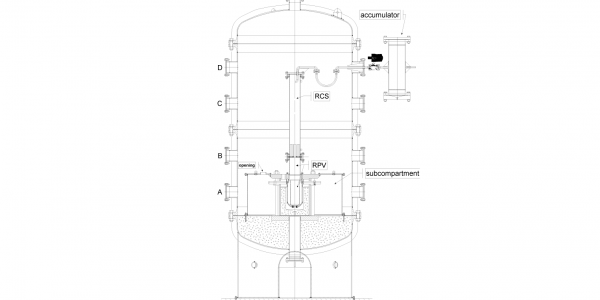
The DISCO-H test facility was set up to perform scaled experiments that simulate melt ejection scenarios under low system pressure in Severe Accidents in Pressurized Water Reactors (PWR). These experiments are designed to investigate the fluid-dynamic, thermal and chemical processes during melt ejection out of a breach in the lower head of a PWR pressure vessel at pressures below 2 MPa with an iron-alumina melt and steam.
The main components of the facility are scaled about 1:18 linearly to a large European reactor: the containment pressure vessel (volume 14 m³), the RPV-RCS pressure vessel (0.08 m³), the cavity, the subcompartment, and the steam accumulator (0.08 m³). The subcompartment is an annular space around the cavity with a volume of 1.74 m³. The flow path from the cavity into the subcompartment is along the eight stubs modeling the main cooling lines (total flow cross section is 0.0308 m²). The connection from the subcompartment to the containment is by four openings with a diameter of 130 mm in its top plate. The RCS-RPV pressure vessel models the volumes of both the reactor cooling system (RCS) and the reactor pressure vessel (RPV). The RPV model, that serves as crucible for the generation of the melt, is bolted to a plate carrying the RCS-RPV pressure vessel. The hole at the bottom of the melt generator is formed by a graphite annulus. It is closed with a brass plate. The reactor pit is made of concrete and is installed inside a strong steel cylinder. Besides the flow path along the main cooling lines there is the option of a flow out of the cavity straight up into the containment through eight openings with a total cross section of 0.052 m². Depending on the reactor design, that is to be investigated, this cross section is variable.
In case of the modeling of a prototypical scenario, the containment vessel is heated by filling with steam additional to the atmospheric air until the pressure reaches 0.2 MPa. The average gas temperature and the wall temperature inside the vessel is 373 K (100°C) at the end of the heat-up. A metered amount of hydrogen gas (3 mol-%) is added to the vessel at the end of heat-up while fans are running inside the vessel. A gas sample is taken just before the start of the experiment.
The pressure vessel modeling the RPV and RCS volume is electrically heated to the saturation temperature of the planned burst pressure, e.g. to 453 K (180°C at 1.0 MPa). It contains nitrogen at that temperature at 0.1 MPa. The steam accumulator is heated electrically to the saturation temperature of twice the planned burst pressure, e.g. 486 K (213°C at 2.0 MPa). The accumulator is filled with a measured amount of water by a high pressure metering pump to reach that pressure. The RCS pressure vessel and the accumulator are connected by a 25 mm diameter pipe with an electro-pneumatically actuated valve.
The model of the RPV is filled with aluminum-ironoxide thermite. The experiment is started by igniting the thermite electro-chemically at the upper surface of the compacted thermite powder. When a pressure increase in the RPV-RCS pressure vessel verifies that the thermite reaction has started, the valve in the line connected to the accumulator is opened and steam enters the pressure vessel. When the pressure has reached a preset value the valve is automatically closed again. About 5 to 8 seconds after ignition the brass plug at the bottom of the RPV vessel is melted by the 2400 K hot iron-alumina mixture. That initiates the melt ejection. The melt is driven out of the breach by the steam and is dispersed into the cavity and the containment.
